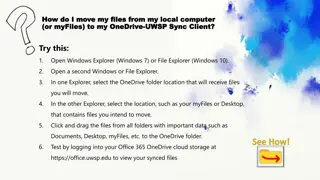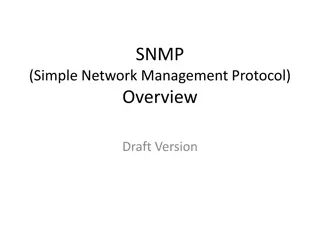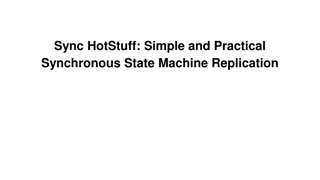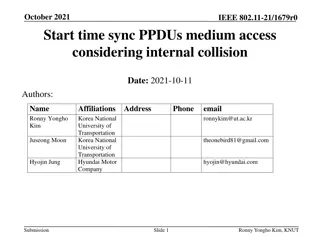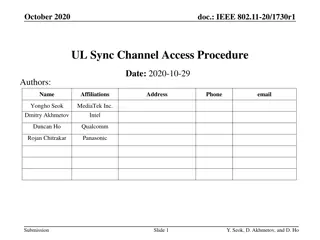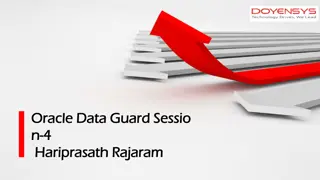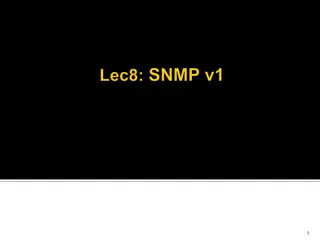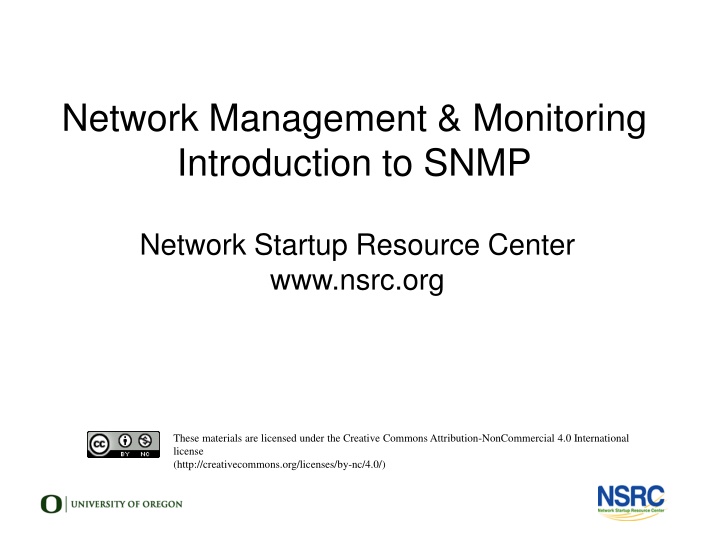
SNMP for Effective Network Management
Explore the basics of SNMP (Simple Network Management Protocol) including its uses, versions, roles, and how it works. Learn how SNMP facilitates monitoring and querying network devices efficiently. Discover the structured protocol and information it provides for managing network equipment effectively.
Uploaded on | 1 Views
Download Presentation

Please find below an Image/Link to download the presentation.
The content on the website is provided AS IS for your information and personal use only. It may not be sold, licensed, or shared on other websites without obtaining consent from the author. If you encounter any issues during the download, it is possible that the publisher has removed the file from their server.
You are allowed to download the files provided on this website for personal or commercial use, subject to the condition that they are used lawfully. All files are the property of their respective owners.
The content on the website is provided AS IS for your information and personal use only. It may not be sold, licensed, or shared on other websites without obtaining consent from the author.
E N D
Presentation Transcript
Network Management & Monitoring Introduction to SNMP Network Startup Resource Center www.nsrc.org These materials are licensed under the Creative Commons Attribution-NonCommercial 4.0 International license (http://creativecommons.org/licenses/by-nc/4.0/)
Overview What is SNMP? Polling and querying OIDs and MIBs Notifications SNMPv3
What is SNMP? SNMP Simple Network Management Protocol Structured protocol, structured information For querying network device state and receiving notifications Also can be used to change state Industry standard, hundreds of tools exist that use it Supported on any decent network equipment Transport : UDP ports 161 and 162 (notifications)
Uses for SNMP Typical queries Bytes In/Out on an interface, errors CPU load Uptime Temperature For hosts (servers or workstations) Disk space Installed software Running processes ...
SNMP Versions v1 (1988) Original specification Historic v2 (1996) Failed Standard Security + new data types + new operators 64-bit counters, get-bulk, v2 notifications View-based access control model (VACM) introduced Historic, no current implementations left v2c (1996) De facto standard v2 data types and operators v1 security (community string) (simple security model) Historic
SNMP Versions cont. v3 (1998) Robust security User/view based security (USM/VACM) Full Internet Standard We will use SNMP v2c and v3 in this class
SNMP roles Terminology We will be using Manager and Agent Manager (the monitoring station) Sometimes known as the SNMP client SNMPv3 calls it the Command Generator and Notification Receiver Agent (running on the equipment/server) Sometimes known as the SNMP server SNMPv3 calls it the Command Responder and Notification Originator Windows and UNIX have SNMP agents
How SNMP works Query / Response
How SNMP works Trap / Inform
How SNMP works Basic operators: get (manager -> agent) Query for a value getnext (manager -> agent) Get next value (e.g. list of values for a table) getresponse (agent -> manager) Response to get, getnext, or set, includes error returns
How SNMP works Basic operators: (manager -> agent) set Set a value, or perform an action (agent -> manager) trap Spontaneous notification from equipment (line down, temperature above threshold, ...)
How SNMP works Query/response based Monitoring generally uses get, getnext, getbulk Changing state uses set Response is always a getresponse getbulk requires v2c or v3 Notifications are delivered as traps or informs traps are unacknowledged informs are acknowledged (v2c, v3) Use v2c format traps No one uses informs
SNMP TRAPS A way for an Agent to notify the Manager without getting a Query from the Manager Agent is configured to send TRAP messages when an event occurs coldStart warmStart ifDown authenticationFailure After the manager receives the TRAP message, it can take further action if necessary
The SNMP database The information offered by a device is available in its Management Information Base (MIB) SNMP uses Object Identifiers (OIDs) to organize this information OIDs are keys to identifying each piece of data OIDs are organized into a tree structure that is the MIB MIB files document parts of the MIB on a device
OIDs OID: Object Identifier A unique key to select a particular item of data in the device The same piece of information is always found at the same OID. That's simple! An OID is a variable-length string of numbers, e.g. .1.3.6.1.2.1.1.3 Allocated hierarchically in a tree to ensure uniqueness (similar to DNS)
The MIB Tree Root(.) iso(1) ccitt(0) joint-iso-ccitt(3) org(3) dod(6) 1.3.6.1 internet(1) directory(1) mgmt(2) experimental(3) private(4) mib-2(1) enterprises(1) host(25) system(1) snmp(11) cisco(9) interfaces(2) hrDevice hrStorage ip(4) hrSystem
The MIB Tree Root(.) iso(1) ccitt(0) joint-iso-ccitt(3) org(3) ciscoMgmt(9) dod(6) ciscoEnvMonMIB(13) 1.3.6.1 ciscoEnvMonObjects(1) internet(1) ciscoEnvMonTemperatureStatusTable(3) directory(1) mgmt(2) experimental(3) private(4) ciscoEnvMonTemperatureStatusEntry(1) mib-2(1) enterprises(1) ciscoEnvMonTemperatureStatusValue(3) cisco(9) system(1) snmp(11) interfaces(2) ip(4) ...
Interesting parts of the MIB tree The Internet MIB, .1.3.6.1, really only two branches of interest: Standard MIBs .1.3.6.1.2.1 = .iso.org.dod.internet.mgmt.mib-2 Vendor-specific (proprietary) MIBs .1.3.6.1.4.1 = .iso.org.dod.internet.private.enterprises
Interesting parts of the MIB tree The IEEE has MIBs of interest in three parts of the tree: IEEE 802 MIBs, including LLDP .1.0.8802 = .iso.standard.iso8802 IEEE 802.3 MIBs, including LAG .1.2.840.10006 = .iso.member-body.us.ieee802dot3 IEEE 802.11 wireless MIBs .1.2.840.10036 = .iso.member-body.us.ieee802dot11
OIDs and MIB files Read from left to right OID components separated by '.' .1.3.6.1.4.1.9. ... Each OID corresponds to a label .1.3.6.1.2.1.1.5 => sysName The complete path: .iso.org.dod.internet.mgmt.mib- 2.system.sysName How do we convert from OIDs to Labels (and vice versa)? Use the MIBs files!
MIB Files MIB files define the objects that can be queried, including: Object name Object description Data type (integer, text, list) MIB files are structured text using an ASN.1 subset called the Structure of Management Information (SMI)
MIB Files Standard MIB files include: MIB-II (RFC1213) a sub-group of MIBs HOST-RESOURCES-MIB (RFC2790)
MIB Sample (1 of 3) sysUpTime OBJECT-TYPE SYNTAX TimeTicks ACCESS read-only STATUS mandatory DESCRIPTION "The time (in hundredths of a second) since thenetwork management portion of the system was lastre- initialized." ::= { system 3 }
MIB Sample (2 of 3) sysUpTime OBJECT-TYPE SYNTAX TimeTicks ACCESS read-only STATUS mandatory DESCRIPTION "The time (in hundredths of a second) since thenetwork management portion of the system was lastre- initialized." ::= { system 3 } sysUpTime OBJECT-TYPE This defines the object called sysUpTime. SYNTAX TimeTicks This object is of the type TimeTicks. Object types are specified in the SMI we mentioned a moment ago. ACCESS read-only This object can only be read via SNMP (i.e., get, getnext); it cannot be changed (i.e., set).
MIB Sample (2 of 3) sysUpTime OBJECT-TYPE SYNTAX TimeTicks ACCESS read-only STATUS mandatory DESCRIPTION "The time (in hundredths of a second) since thenetwork management portion of the system was lastre- initialized." ::= { system 3 } STATUS mandatory This object must be implemented in any SNMP agent. DESCRIPTION A description of the object ::= { system 3 } The sysUpTime object is the third branch off of the system object group tree.
MIB Files MIB files also make it possible to interpret a returned value from an agent For example, the status for a fan could be: 1, 2, 3, 4, 5, or 6 What does it mean? Look for the Textual Convention (tc) in the MIB
MIB Sample CiscoEnvMonState ::= TEXTUAL-CONVENTION STATUS current DESCRIPTION "Represents the state of a device being monitored. Valid values are: normal(1): the environment is good, such as low temperature. warning(2): the environment is bad, such as temperature above normal operation range but not too high. critical(3): the environment is very bad, such as temperature much higher than normal operation limit. shutdown(4): the environment is the worst, the system should be shutdown immediately. notPresent(5): the environmental monitor is not present, such as temperature sensors do not exist. notFunctioning(6): the environmental monitor does not function properly, such as a temperature sensor generates a abnormal data like 1000 C.
SNMP and Security SNMP versions 1 and 2c are insecure SNMP version 3 was created to fix this SNMPv3 authentication is based on a User-based Security Model (USM): Authenticity and integrity Keys are used for users, and messages have digital signatures generated with a hash function (MD5 or SHA) Privacy Messages can be encrypted with secret-key (private) algorithms (DES or AES) Temporary validity Utilizes a synchronized clock with a 150 second window with sequence checking
SNMPv3 Security Levels noAuthNoPriv No authentication, no privacy authNoPriv Authentication with no privacy authPriv Authentication with privacy
Cisco SNMP Agent Configuration R/O Read-only # snmp-server community NetManage RO Enables SNMPv1 and v2c # snmp-server group ReadGroup v3 auth # snmp-server user admin ReadGroup v3 auth sha NetManage SNMPv3 authentication, no encryption
Cisco SNMP Agent Configuration R/W Read-write # snmp-server group WriteGroup v3 auth write v1default # snmp-server user admin-rw WriteGroup v3 auth sha NetManage priv aes 128 NetWrite Cisco allows authNoPriv and authPriv queries with this user You could also define a read-write user without encryption (priv) Note that we recommend using SNMP version 3 if you want write access using the set operator
Net-SNMP Agent (snmpd) Add a community string by editing /etc/snmp/snmpd.conf and adding: rocommunity NetManage 100.64.0.0/16 Add the SNMPv3 user # systemctl stop snmpd # net-snmp-create-v3-user X DES -a NetManage admin # system start snmpd
Querying an SNMP agent Using Net-SNMP command line tools... Some typical commands for querying: snmpget snmpwalk snmpbulkwalk (requires v2c or v3) snmpstatus snmptable All commands have same authentication options: snmpXXX -v1 -c<community> host [OID] snmpXXX -v2c -c<community> host [OID] snmpXXX -v3 -lauthNoPriv -u<user> -X DES -a<pass> host [OID]
Using defaults Set defaults in config file ~/.snmp/snmp.conf defVersion 3 defCommunity NetManage defSecurityName admin defSecurityLevel authNoPriv defAuthPassphrase NetManage defAuthType SHA After creating this file the commands are much shorter: snmpxxx host [OID] Or, if you want to force the version to v2c: snmpxxx -v2c host [OID]
Querying an SNMP agent Let's look at some examples $ snmpstatus 100.64.Y.1 $ snmpget 100.64.Y.1 ifNumber.0 $ snmpwalk -v2c 100.64.Y.1 ifDescr Y == your campus number
Querying an SNMP agent Authentication options From command line flags or snmp.conf OID A value, for example, .1.3.6.1.2.1.1.5.0 or its name equivalent: sysName.0 Let's ask for the system's name (using the OID above) Why the .0? What do you notice?
Queries Using snmp.conf Two walks: # snmpwalk 100.64.0.251 sysUpTime DISMAN-EVENT-MIB::sysUpTimeInstance = Timeticks: (1946738) 5:24:27.38 # snmpwalk -v2c 3 100.64.0.251 sysUpTime DISMAN-EVENT-MIB::sysUpTimeInstance = Timeticks: (1953429) 5:25:34.29 First walk used SNMPv3 as it was the default in snmp.conf, second walk specified SNMPv2c, and used the community string from snmp.conf.
Failed Query...Why? Two gets: # snmpget -v1 100.64.0.251 ifHCInOctets.1 Error in packet Reason: (noSuchName) There is no such variable name in this MIB. Failed object: IF-MIB::ifHCInOctets.1 # snmpget 100.64.0.251 ifHCInOctets.1 IF-MIB::ifHCInOctets.1 = Counter64: 475028252 Why? Notice the data type: Counter64. 64-bit counters are only supported in SNMPv2c and v3. 64-bit counters are important because 32-bit interface counters (ifInOctets) can wrap in 34 seconds on Gig interfaces. (How fast can it wrap on 10G?) snmpstatus: Unsupported security level # SNMPv3 configuration snmpstatus: Unknown user name # problems
SNMP failure: no response? The device might be offline or unreachable The device might not be running an SNMP agent The device might be configured with a different community string The device might be configured to refuse SNMP queries from your IP address In all of these cases you will get no response
SNMP Best Practices Secure your SNMP access and traffic: Management VLAN Access lists Use SNMPv3 with authentication for queries and sets where possible Use SNMPv2c traps Better formatted than v1 traps Accurate timestamps Do no harm Only poll as fast as you really need Possible to drive CPU load on devices up and affect other protocol processing It does no good to poll every 5 seconds if the device updates the counter every 10
Coming up in our exercises... Using snmpwalk, snmpget Config file: ~/.snmp/snmp.conf or /etc/snmp/snmp.conf Running Linux SNMP agent (daemon) Config file: /etc/snmp/snmpd.conf Loading MIBs
References Essential SNMP (O Reilly Books) by Douglas Mauro, Kevin Schmidt http://www.amazon.com/Essential-Second-Edition-Douglas-Mauro/dp/0596008406 Wikipedia http://en.wikipedia.org/wiki/Simple_Network_Management_Protocol MIB/OID Browser http://oid-info.com/ Cisco SNMP on IOS, MIB tools, and MIB/OID browser http://www.cisco.com/c/en/us/td/docs/ios-xml/ios/snmp/command/nm-snmp-cr- book.html http://tools.cisco.com/ITDIT/MIBS/servlet/index http://tools.cisco.com/Support/SNMP/do/BrowseOID.do?local=en&substep=2&transl ate=Translate&tree=NO
References Open Source Java MIB Browser http://www.dwipal.com/mibbrowser.htm SNMP Link collection of SNMP resources http://www.snmplink.org/ Net-SNMP Open Source SNMP tools http://net-snmp.sourceforge.net/ Integration with Nagios https://web.archive.org/web/20100614010336/http://www.cisl.ucar.edu/nets/tool s/nagios/SNMP-traps.html
SNMP Versions v1 Original specification RFCs 1155,1157,1213 v2 Security + new data types + new operators RFCs 1901,1909-1910, 2011, 2576, 2578- 2580, 3416-3418 v2c De facto standard Documented in RFC 3584 v3 Robust security: USM/VACM RFCs 3411-3415, 3417- 3418, 3826, 5343, 5345, 5590 RFC 3584 specifies coexistence between versions










